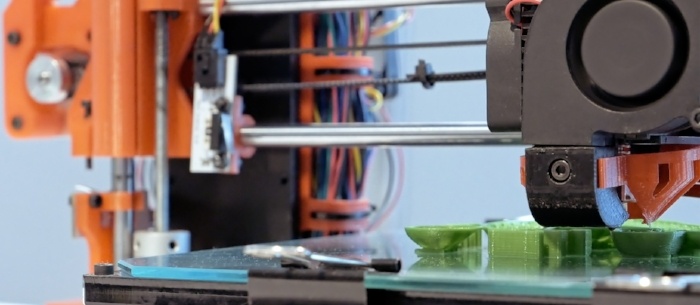October 6, 2021 | Aerospace and Defense, Additive Manufacturing
Top 5 Uses for Additive Manufacturing in Aerospace and Defense Industries
Additive manufacturing can be used in countless industries and applications, ranging from making small-scale prototypes to producing refined rocket engines. If you’re still on the fence about incorporating additive manufacturing technologies into your manufacturing operations, consider its many benefits and pioneering applications in the aerospace and defense industries.
Quick Links:
- What Is Additive Manufacturing?
- Benefits of Additive Manufacturing
- Aerospace Uses for Additive Manufacturing
- Military and Defense Uses for 3D Printing
- Interested to Learn More About the Benefits of Additive Manufacturing?
What Is Additive Manufacturing?
Additive manufacturing, also known as 3D printing, is the process of creating a three-dimensional object from a digital 3D or CAD model. As is implied by the name, additive manufacturing works by adding materials layer by layer to build an object. These materials can include metal powders, plastic, or ceramics. Additive manufacturing can augment, and in some cases, totally replace traditional methods of creating objects like machining, cutting, turning, shaping, milling, and other “subtractive” manufacturing processes.
During the additive manufacturing process, an object is designed using CAD (Computer-Aided Design) software or by taking a scan of the object that will be printed. The software can translate the scan into a precise framework for the 3D printing machine to follow layer by layer.
Benefits of Additive Manufacturing

There are a plethora of advantages inherent to utilizing additive manufacturing, including:
Lowered Development Costs
Advanced manufacturing technology has the stereotype of being somewhat pricey, due to its initial cost; however, the long-term reduced development costs yield money-saving benefits. One of the main advantages of 3D printing is the reduced cost of labor. Aside from post-processing, most printers are self-sufficient and hardly need assistance from an operator. Therefore, the labor costs associated with the additive manufacturing process are essentially nonexistent in comparison to traditional manufacturing processes that can require highly skilled operators.
Additionally, additive manufacturing at low volumes is competitive in cost compared to traditional manufacturing. It’s often significantly less expensive to 3D print a prototype than to produce it using other manufacturing methods, such as injection molding (think die leadtime and cost), milling, and machining.
Reduced Product Waste
By designing drafts in a computer program and then sending them to be printed, the time to create and produce new designs is drastically shortened with less waste; this digital-to-digital process removes the additional intermediate steps of traditional prototyping that can result in material waste. Depending on the material used, this reduction can also result in significant cost reduction e.g. if the required material is titanium.
Additionally, 3D printing has accelerated turnaround time—with the ability to create quick iterations, 3D printing identifies engineering and design issues that may have taken weeks, if not months, to discover in traditional manufacturing. Since additive manufacturing enables the creation of complex designs that are normally too difficult or too expensive to manufacture, process development can be accomplished faster than traditional manufacturing processes. This means more time and money can be utilized in other manners. Overall, additive manufacturing offers a more effective and efficient design process with less waste and reduced spending.
Truly Advanced Prototyping
With additive manufacturing, you can design and produce a prototype on a 3D printer in hours—not weeks! Rather than designing for manufacturing, you can now manufacture for utility and use. In addition, parts can be produced to specifically meet complex customer specifications; this is a game-changer for prototyping.
Additive manufacturing means you can now quickly produce mock-ups of a new product and produce a part to meet a specific market niche, which could lead to the production of high-profit margin products. The overarching manufacturing process becomes further streamlined with the incorporation of additive manufacturing from start to finish.
Aerospace Uses for Additive Manufacturing
Considering the benefits of additive manufacturing, it makes sense that such a technology would be applied to uses in the aerospace industry. Such trends include:
Building Rocket Bodies
Relativity Space is an American aerospace manufacturing company headquartered in Los Angeles, California that focuses on developing manufacturing technologies, launch vehicles, and rocket engines for commercial orbital launch services. Their Stargate manufacturing facility houses the world’s largest metal 3D printers and uses directed energy deposition and patented alloys to make the bodies of their rockets.
3D printing allows them to rapidly design integrated components that reduce the part count by 100 times compared to traditional launch vehicles. This also saves weight and improves reliability, both of which are hugely important to the economics of launching into space.
Constructing Rocket Engines
Rocket Lab is a public American aerospace manufacturer and small satellite launch service provider. Their Rutherford rocket engine was first tested in late 2016, and since then, over 200 of these game-changing models have been produced.
The combustion chambers of this particular engine, injectors, pumps, and main propellant valves are all 3D printed using electron-beam melting. The resulting engine is simple, reliable, and light—only 35 kg or 77 lb—making them ideal for low-cost launches into space. And beyond Earth’s atmosphere, their new Curie and HyperCurie thrusters are built using the same principles.
Advancing Astronaut Uniforms

Additive manufacturing isn’t just used for the physical rocket; this technology can be utilized in producing advanced, refined astronaut uniforms, too. When SpaceX sent humans into space, their crew’s uniforms were partially made with additive manufacturing.
Though the corporation has kept details of much of the underlying technology private, a spokesperson noted that “the helmet is custom manufactured using 3D printing technology and includes integrated valves, mechanisms for visor retraction and locking, and microphones within the helmet’s structure.”
Military and Defense Uses for 3D Printing
Advances are being made in the defense industry with additive manufacturing, too, including:
Jointless Hull Project
In April, the United States Army signed a contract for its “Jointless Hull Project,” which has an ambitious goal of developing a 3D metal printer so large that it can create a military truck exterior in one giant piece. The mission is to develop a large-scale tool capable of producing single, jointless combat vehicle hulls at a near net size of 30’ by 20’ by 12’ in size.
Mine-Clearing Missions
The US Marine Corps successfully leveraged additive manufacturing to aid their mine-clearing mission by 3D printing a headcap for a rocket motor that is used to detonate an M58 Mine Clearing Line Charge (MICLIC).
The MICLIC is a rocket-projected explosive line charge that clears a path through minefields and other obstacles on the battlefield. Utilizing additive manufacturing to produce the headcap enabled the Marines to overcome the costly and time-heavy drawbacks of traditional manufacturing techniques, and provide a more efficient method for producing the part. The headcap was 3D printed in stainless steel before being tested at Yuma Proving Ground in Arizona. During the test event, the 3D-printed headcap was fitted to a rocket motor that was used to successfully detonate a mine-clearing line charge.
Interested to Learn More About the Benefits of Additive Manufacturing?
Additive manufacturing is a game-changer for manufacturers of all sizes. It can enable them to create products faster and cheaper— and with less production waste and better precision. When you look at the bigger picture, AM is also changing the lives of everyday Americans, from medical breakthroughs to safer transportation and roadways.
Start growing your business today with additive manufacturing—and if you don’t know where to start, reach out to our experts today! CMTC is here to help guide small to medium-sized manufacturers towards solutions that can impact their business for sustainable and impactful growth.
About the Author
Gregg Profozich
Gregg Profozich is a manufacturing, operations and technology executive who believes that manufacturing is the key creator of wealth in the economy and that a strong manufacturing sector is critical to our nation’s prosperity and security now, and for future generations. Across his 20-year plus career in manufacturing, operations and technology consulting, Mr. Profozich helped manufacturing companies from the Fortune 500 to the small, independents significantly improve their productivity and competitiveness.

Leave a Comment